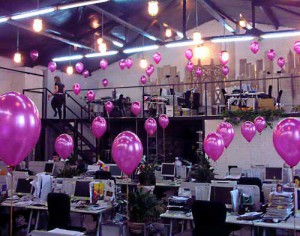 Personal well-being and the beauty of products and services. It is not always possible to correlate the work process of an employee directly to the products of services that an organisation produces, and this is especially the case in big organisations. For the production of products, it’s possible to argue that the happiness of personnel is of influence on the beauty of products that are produced, but that might be a bit far fetched.
Personal well-being and the beauty of products and services. It is not always possible to correlate the work process of an employee directly to the products of services that an organisation produces, and this is especially the case in big organisations. For the production of products, it’s possible to argue that the happiness of personnel is of influence on the beauty of products that are produced, but that might be a bit far fetched.
However, the picture changes when we take a look at services organizations. One of the key characteristics of service processes is its simultaneous production and consumption of them. Service organizations have to “get it right first time”. In these “service encounters”, or “moments of truth”,aesthetic aspects of a service (especially the “software” of the service) can mean the difference between a satisfied (and returning) customer and a dissatisfied customer.
As Schlesinger and Heskett have shown, there are no satisfied customers without satisfied service employees who have a good service attitude. The commercial utility of the aesthetic gaze and manners of service personnel is well recognized by high-street retailers, banks, hospitality outlets and airline companies .In these branches, personnel with aesthetic qualities (e.g. people who look “good” sound “right” and have the “right” manners) are recruited and selected, and their aesthetic qualities and sensibilities are trained. For them, the difference between the beauty of the producer, the beauty to produce and the beauty of the produced is no more.
What I said about the relation between the beauty of an organisational design and the beauty of the organisational processes this design gives rise to? Well, for instance, that Ramirez states that “it is not possible to set out to design Aesthetics from a design perspective to a beautiful organization, and, by carrying out the ‘right’ procedures, to succeed.” And yet, despite this earlier research, why not go for the initially impossible? Let us take the field of architecture. Here, the idea that people that work and live in beautiful surroundings will themselves live and work at an aesthetically elevated level, is an old but lively one. The European modernist architects of the 1890-1930 were strongly inspired by such ideas.
With aesthetic sensibility, we mean the personal ability – the mental skill – to experience beauty. Many of the descriptions of this “aesthetic attitude” and, even, of “the function of aesthetics” suggest similarities with what the organisation literature tends to describe as desirable characteristics of managerial behaviour.
Discussing technology and its roles and aesthetics in cross-disciplinary digital art making is a vast subject that calls for a review for the novel working and collaboration methodologies. An attempt to have a position on the matter requires looking at the different ways technology was integrated in the art making process, and the role it plays in the final product. Heidegger defines technology as “means to an end”, which compels us to look at technology as a production tool.
However, with the emergence of computer vision tracking, sensor electronics, microprocessors, and real time sound computing, technology can also play an active role in shaping the artistic the experience, in which case it becomes a means to an experiential and aesthetical end, therefore an essential element in the aesthetic and design decisions that should be considered when performing a critical analysis of the process of creative conception. The use of technology as a medium for artistic expression imposes rigorous conditions that may (or may not) limit the artistic freedom of the artist or the performers, but can also open a lot of potentialities to examine and play with.
Computer systems that perform motion analysis and gesture tracking need highly controlled environments and high-performance machines, which might affect the portability of this system. Off the shelf computer technologies impose certain limitations on image processing and motion analysis due to limited processing power; therefore they generate images and effects with quality and resolution that can’t compete with human vision and hearing, and open to question attempts for realism.
Building instruments removes the complexity and overhead of technical development, provides clear expectations of the potentials of these instruments, and allows content creators and performers to focus on experience design and the aesthetics of the work instead of worrying about the technical obstacles, thus making technology in this context a means to an end and an active element of the final experience.
